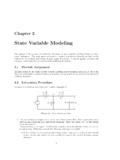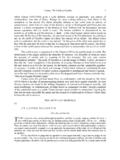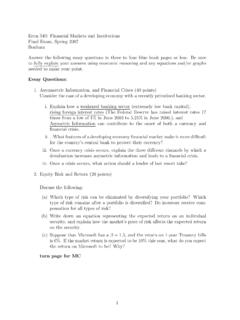Transcription of Method of Joints - University of Hawaii System
1 Method of Joints The Method of Joints is one of the simplest methods fordetermining the force acting on the individual members of atruss because it only involves two force equilibrium of Joints The Method of Joints is one of the simplest methods fordetermining the force acting on the individual members of atruss because it only involves two force equilibrium equations. Since only two equations are involved, only two unknowns canbe solved for at a time. Therefore, you need to solve thejoints in a certain order. That is, you need to work from thesides towards the center of the of Joints The Method of Joints is one of the simplest methods fordetermining the force acting on the individual members of atruss because it only involves two force equilibrium equations. Since only two equations are involved, only two unknowns canbe solved for at a time. Therefore, you need to solve thejoints in a certain order. That is, you need to work from thesides towards the center of the truss.
2 Since you need to work in a certain order, the Method ofSections (which will be covered later) can be more useful ifyou just want to know the forces acting on a particularmember close to the center of the of JointsLet s start with joint A. We begin by drawing all the forces thatact on the bolt at joint of JointsLet s start with joint A. We begin by drawing all the forces thatact on the bolt at joint thatFABpoints towards the joint . This is becauseFABandthe 15 N force are the only vertical forces. ThereforeFABmustpoint downwards to balance the 15 N force pointing of JointsLet s start with joint A. We begin by drawing all the forces thatact on the bolt at joint thatFABpoints towards the joint . This is becauseFABandthe 15 N force are the only vertical forces. ThereforeFABmustpoint downwards to balance the 15 N force pointing helps us determine the direction pointaway from the joint since that is the only way to balance the forcesin the horizontal of Joints - Direction of Forces determining the direction of the unknown forces is a goodidea.
3 You can still solve the problem if you choose thedirections incorrect, but you will get negative values for theforce. Therefore, it is best to figure this out when possible. Ina few cases, it is not possible so you have to of Joints - Direction of Forces determining the direction of the unknown forces is a goodidea. You can still solve the problem if you choose thedirections incorrect, but you will get negative values for theforce. Therefore, it is best to figure this out when possible. Ina few cases, it is not possible so you have to guess. To get the directions for the unknown forces correct, you needto proceed in the correct order. Look back at the unknownforces,FABandFAC. They both have horizontal components,but onlyFABhas a vertical of Joints - Direction of Forces determining the direction of the unknown forces is a goodidea. You can still solve the problem if you choose thedirections incorrect, but you will get negative values for theforce.
4 Therefore, it is best to figure this out when possible. Ina few cases, it is not possible so you have to guess. To get the directions for the unknown forces correct, you needto proceed in the correct order. Look back at the unknownforces,FABandFAC. They both have horizontal components,but onlyFABhas a vertical component. Since only one of the unknowns,FABhas a verticalcomponent, figure out the direction ofFABfirst. To do this,balance out the forces in the vertical direction. Since the onlyother force in the vertical direction is the 15 N force pointingup,FABmust point down, or towards the of Joints - Direction of Forces determining the direction of the unknown forces is a goodidea. You can still solve the problem if you choose thedirections incorrect, but you will get negative values for theforce. Therefore, it is best to figure this out when possible. Ina few cases, it is not possible so you have to guess. To get the directions for the unknown forces correct, you needto proceed in the correct order.
5 Look back at the unknownforces,FABandFAC. They both have horizontal components,but onlyFABhas a vertical component. Since only one of the unknowns,FABhas a verticalcomponent, figure out the direction ofFABfirst. To do this,balance out the forces in the vertical direction. Since the onlyother force in the vertical direction is the 15 N force pointingup,FABmust point down, or towards the joint . Once you know the direction ofFAB, you can see that boththe 120 N force andFABpoint to the left, soFACmust pointto the right, or away from the the directions of forces in truss members When a force points toward the joint , the member is said tobe incompression. If the force points away from the joint ,the member is said to be the directions of forces in truss members When a force points toward the joint , the member is said tobe incompression. If the force points away from the joint ,the member is said to be intension. It is often important to know whether a truss member is intension or in compression because some building materialshave different strengths in compression versus of Joints - Solving for forces at joint AStart by considering the horizontal and vertical forces.
6 In thehorizontal direction, you have two unknowns,FABandFAC. In thevertical direction, you only have one unknown,FAB. Therefore,start with balancing the forces in the vertical of Joints - Solving for forces at joint AStart by considering the horizontal and vertical forces. In thehorizontal direction, you have two unknowns,FABandFAC. In thevertical direction, you only have one unknown,FAB. Therefore,start with balancing the forces in the vertical direction. To breakFABinto components, consider the right triangle that is describedby the 32+ 42= 55vert. comp. 35hor. comp. 45 Method of Joints - Solving for forces at joint AStart by considering the horizontal and vertical forces. In thehorizontal direction, you have two unknowns,FABandFAC. In thevertical direction, you only have one unknown,FAB. Therefore,start with balancing the forces in the vertical direction. To breakFABinto components, consider the right triangle that is describedby the 32+ 42= 55vert.
7 Comp. 35hor. comp. 45 + Fy= +15N 35 FAB= 0 Method of Joints - Solving for forces at joint AStart by considering the horizontal and vertical forces. In thehorizontal direction, you have two unknowns,FABandFAC. In thevertical direction, you only have one unknown,FAB. Therefore,start with balancing the forces in the vertical direction. To breakFABinto components, consider the right triangle that is describedby the 32+ 42= 55vert. comp. 35hor. comp. 45 + Fy= +15N 35 FAB= 0 FAB=53(15N) = 25N(compression) Method of Joints - Solving for forces at joint ANow we can solve forFACby summing forces in the 25 NFAC43 32+ 42= 55vert. comp. 35hor. comp. 45 Method of Joints - Solving for forces at joint ANow we can solve forFACby summing forces in the 25 NFAC43 32+ 42= 55vert. comp. 35hor. comp. 45 + Fx= 120N 45 FAB+FAC= 0 Method of Joints - Solving for forces at joint ANow we can solve forFACby summing forces in the 25 NFAC43 32+ 42= 55vert.
8 Comp. 35hor. comp. 45 + Fx= 120N 45 FAB+FAC= 0 FAC= 120 +45(25N) = 140N(tensionsion) Method of Joints - joint BNow we can proceed to joint B. SinceFABhas been determined, joint B has only two unknowns, NFAB25 NFBCFBDM ethod of Joints - joint BNow we can proceed to joint B. SinceFABhas been determined, joint B has only two unknowns, NFAB25 NFBCFBDHere it is straightforward to figure out the directions of theunknowns. SinceFBCis the only unknown force with a verticalcomponent, it must point down (away from the joint ) to balancethe vertical component of Joints - joint BNow we can proceed to joint B. SinceFABhas been determined, joint B has only two unknowns, NFAB25 NFBCFBDHere it is straightforward to figure out the directions of theunknowns. SinceFBCis the only unknown force with a verticalcomponent, it must point down (away from the joint ) to balancethe vertical component ,FBDmust point left, towards the joint , to balance the120 N force and the horizontal component of Joints - joint BbB120 NFAB25 NFBCFBD345 Method of Joints - joint BbB120 NFAB25 NFBCFBD345 + Fy= +35 FAB FBC= 0 Method of Joints - joint BbB120 NFAB25 NFBCFBD345 + Fy= +35 FAB FBC= 0 FBC=35(25N) = 15N(tension) Method of Joints - joint BbB120 NFAB25 NFBCFBD345 + Fy= +35 FAB FBC= 0 FBC=35(25N) = 15N(tension) + Fx= +120N+45 FAB FBD= 0 Method of Joints - joint BbB120 NFAB25 NFBCFBD345 + Fy= +35 FAB FBC= 0 FBC=35(25N) = 15N(tension) + Fx= +120N+45 FAB FBD= 0 FBD= +120N+45(25N) = 140N(compression) Method of Joints - joint CNow that we have solved Joints A and B, we can proceed to jointC.
9 SinceFACandFBChave been determined, joint C has only twounknowns, NFBC15 NFCDFCEM ethod of Joints - joint CNow that we have solved Joints A and B, we can proceed to jointC. SinceFACandFBChave been determined, joint C has only twounknowns, NFBC15 NFCDFCES inceFCDis the only unknown force with a vertical component,balancing forces in the vertical direction shows thatFCDmustpoint down, and toward the of Joints - joint CNow that we have solved Joints A and B, we can proceed to jointC. SinceFACandFBChave been determined, joint C has only twounknowns, NFBC15 NFCDFCES inceFCDis the only unknown force with a vertical component,balancing forces in the vertical direction shows thatFCDmustpoint down, and toward the we know thatFCDpoints to the left,FCEmust point right,away from the joint , to balance the forces in the of Joints - joint CbCFAC140 NFBC15 NFCDFCE435 Balancing forces, we get: Method of Joints - joint CbCFAC140 NFBC15 NFCDFCE435 Balancing forces, we get: + Fy= +FBC 35 FCD= 0 Method of Joints - joint CbCFAC140 NFBC15 NFCDFCE435 Balancing forces, we get: + Fy= +FBC 35 FCD= 0 FCD=53(15N) = 25N(compression) Method of Joints - joint CbCFAC140 NFBC15 NFCDFCE435 Balancing forces, we get: + Fy= +FBC 35 FCD= 0 FCD=53(15N) = 25N(compression) + Fx= FAC 45 FCD+FCE= 0 Method of Joints - joint CbCFAC140 NFBC15 NFCDFCE435 Balancing forces, we get.
10 + Fy= +FBC 35 FCD= 0 FCD=53(15N) = 25N(compression) + Fx= FAC 45 FCD+FCE= 0 FCE= 140N+45(25N) = 160N(tension) Method of Joints - joint HNow that we have gotten close to the center, we should move tothe opposite side of the truss, namely joint NFFHFGHM ethod of Joints - joint HNow that we have gotten close to the center, we should move tothe opposite side of the truss, namely joint NFFHFGHS inceFFHis the only unknown force that has a verticalcomponent, balancing the vertical forces means thatFFHmustpoint down, towards the of Joints - joint HNow that we have gotten close to the center, we should move tothe opposite side of the truss, namely joint NFFHFGHS inceFFHis the only unknown force that has a verticalcomponent, balancing the vertical forces means thatFFHmustpoint down, towards the the direction ofFFHhas been determined, balancing forces inthe horizontal direction means thatFGHmust point to the left,away from the of Joints - joint HbH135 NFFHFGH435 Balancing forces gives.










